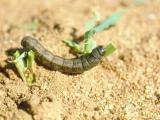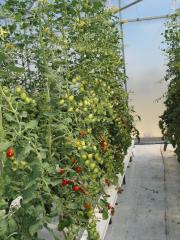Exotic pest
The exotic Queensland fruit fly was first detected in Western Australia in green tomatoes in 1989 and subsequently eradicated.
The Mediterranean fruit fly sometimes attacks vine ripened tomatoes in suburban backyards. Spray with a splash bait containing spinosad weekly to reduce pest numbers. Place insect exclusion bags or sleeves, which are made from waxed paper or insect netting, over the green fruits.
Common pests
Aphids
Aphids are most commonly seen in spring and autumn when the weather is mild and humid. They are small, soft-bodied, green, grey or black insects with thin legs. Aphids may be winged or wingless and are usually slow moving. The insects cluster on the tips of the plant shoots. By sucking the sap they reduce the vigour of the plants. Aphids can also be carriers of virus disease which can severely reduce yields and quality.
In a healthy garden aphids will be controlled by beneficial insects, but these normally take two weeks to build to sufficient numbers to reduce aphid populations. Aphids can be squashed with finger and thumb or reduced by spraying soapy water or knocked from the plants using a water jet from the hose.
Organic controls include horticultural (potassium) soap, horticultural oil and rotenone dust (derris). Imidacloprid is a low toxicity systemic. Other insecticides include dimethoate, cyfluthrin, tau-fluvalinate or pyrethrum and piperonyl butoxide.
Budworm
These caterpillars are tough-skinned, brown, reddish or green and are about 40mm long when fully grown. They have irregular dark stripes on their back and a lighter stripe on each side of the body. Budworms bore holes in the fruit.
These pests are hard to kill and it is important that any infestation is tackled early in the season before the fruit becomes vulnerable to attack. They are common in summer.
The caterpillars pupate in the soil. The moths have light brown forewings and the hind wings have a darker brown margin on the trailing edge. They lay small white visible eggs on the plants, which are a sign of a pending attack.
Pick off the caterpillars or spray early as the small caterpillars are easier to kill and at this stage have caused less damage.
Bacillus thuringiensis is an organic spray. Spinosad (low toxicity), pyrethrin, cyfluthrin or tau-fluvalinate and fluvalinate can also be used on caterpillars.
Cutworms

Cutworms are several species of caterpillars which live in the soil during the day and attack the plant at night. Young seedlings are the most vulnerable to attack. The cutworms damage the stem at the base causing the plant to collapse.
A stout, brown or black, herring-boned, softbodied, hairless caterpillar about 4cm long may be found in the soil surrounding the plant.
When disturbed, it curls up nose to tail. The caterpillar pupates in the soil and emerges as a medium-sized, grey-bodied moth with dark wings. Prevent cutworm attack by placing small, open-ended plastic cups around plants or by wrapping plant bases with aluminium foil. Cutworms are only active at night, so go out after dark with a torch and check for caterpillars at work.
Control with evening sprays of bacillus thuringiensis, spinosad, diazinon, cyfluthrin, or pyrethrin.
Looper caterpillars
These are voracious foliage feeders of tomatoes, potatoes, and other vegetables. They are soft-bodied caterpillars, usually green with bright-coloured bands on either side of the body, and are about 40mm long when fully grown. They move with a distinctive looping action. Mainly found in the summer, they eat large holes in the foliage and may attack young flowers and fruit.
The insects pupate in the soil and emerge as brown, medium-sized moths which are sometimes active during the day. They have silvery marks on the forewings.
Control with sprays of bacillus thuringiensis, spinosad, cyfluthrin, or diazinon.
Two-spotted mite or red spider mite

A serious summer pest of tomatoes, two-spotted mites are usually first noticed by the appearance of the leaves, which begin to look scorched, russetty and dry. The undersides of the affected leaves usually have fine webs concealing hundreds of small, green to red mites and pearly eggs. The mites suck the sap of the leaves and breed very rapidly in warm weather.
When the infestation becomes severe they are almost impossible to control as they are present in such large numbers. They are also resistant to many sprays.
Numbers can be reduced by spraying water beneath the leaves.
Organic sprays must also be used beneath the leaves and include horticultural (potassium) soap and wettable sulphur. Insecticides include dicofol and dimethoate.
Root-knot nematode
The root knot nematode or eelworm is a minute worm that cannot be seen with the naked eye.
It attacks most vegetables and may severely damage tomatoes. Damage is seen as enlarged swellings on the roots and wilting of the plants.
Gardeners can use solarisation (using a clear plastic sheet to heat the soil in summer for one month) or clean soil using a biofumigant by growing a crop of mustard or marigolds. For further information read the DAFWA web article 'Nematodes'.
Thrips
Thrips do not cause severe injury to tomatoes, but are carriers of the spotted wilt virus disease, which seriously damages tomato plants.
Thrips are small, yellow, green, grey, or black torpedo-shaped insects with or without feathery wings, which are usually folded along the back. They have sucking mouthparts which slit the surface and withdraw the sap of the leaves, fruit, and flowers. Routine spraying is essential where spotted wilt virus is a problem. This helps to keep thrips to a minimum. Spraying is most important in the early stages of plant growth.
When the infestation becomes severe they are almost impossible to control as they are present in such large numbers. They are also resistant to many sprays.
Control with dustings of sulfur or thorough spraying with good coverage of the undersides of the leaves using horticultural soap, imidacloprid, cyfluthrin, diazinon or dimethoate.
Tomato russet mite or tomato mite
These mites are most severe in summer and autumn. They are cream and torpedo-shaped and much smaller than two-spotted mites and can only be seen with a hand lens with a magnification of 20 times. Damage symptoms include bronzing of the stem, withering of the lower leaves and leathery skin on the fruit. The flavour of the fruit is also affected.
Control with horticultural (potassium) soap, dicofol or dust with sulphur.
Whitefly
Whiteflies are tiny sap-sucking insects often found on the undersides of leaves. Whitefly adults resemble very small moths and fly in large numbers when disturbed. The young stages have no wings and look more like scale insects. They may be difficult to control. Insects such as lace-wings, ladybirds and hoverflies will feed on whiteflies.
Sprays of horticultural (potassium) soap, bioallethrin and bioresmethrin will also help to reduce whiteflies and also leafhoppers, which are tiny leaf-sucking insects that may damage seedlings and small plants.
Unfamiliar pests
Unfamiliar pests could cause significant problems for our primary industries and environment if they were to become established in Western Australia.
So if you see an unusual pest please contact the Pest and Disease Information Service (PaDIS) on 1800 084 881 or enquiries@agric.wa.gov.au.

